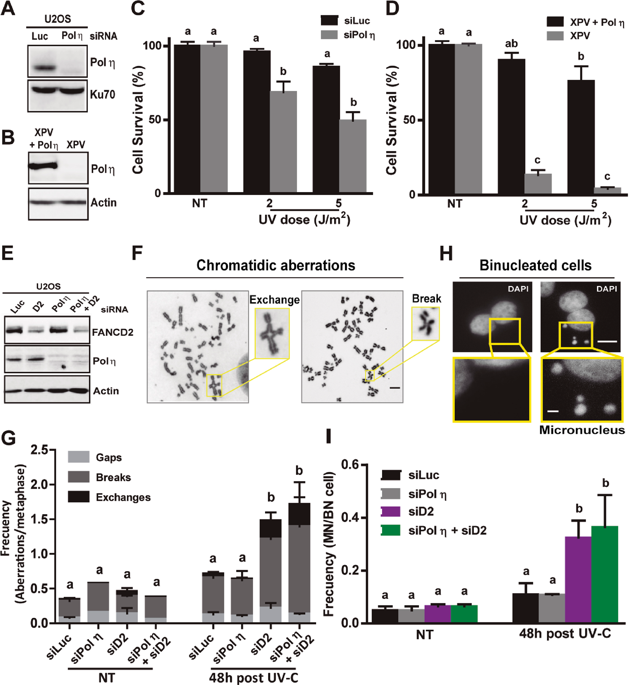Our official English website, www.x-mol.net, welcomes your
feedback! (Note: you will need to create a separate account there.)
Unscheduled MRE11 activity triggers cell death but not chromosome instability in polymerase eta-depleted cells subjected to UV irradiation.
Oncogene ( IF 6.9 ) Pub Date : 2020-03-23 , DOI: 10.1038/s41388-020-1265-9 María Belén Federico 1 , Sebastián Omar Siri 1 , Nicolás Luis Calzetta 1 , Natalia Soledad Paviolo 1 , María Belén de la Vega 1 , Julieta Martino 1 , María Carolina Campana 1 , Lisa Wiesmüller 2 , Vanesa Gottifredi 1
Oncogene ( IF 6.9 ) Pub Date : 2020-03-23 , DOI: 10.1038/s41388-020-1265-9 María Belén Federico 1 , Sebastián Omar Siri 1 , Nicolás Luis Calzetta 1 , Natalia Soledad Paviolo 1 , María Belén de la Vega 1 , Julieta Martino 1 , María Carolina Campana 1 , Lisa Wiesmüller 2 , Vanesa Gottifredi 1
Affiliation

|
The elimination of DNA polymerase eta (pol η) causes discontinuous DNA elongation and fork stalling in UV-irradiated cells. Such alterations in DNA replication are followed by S-phase arrest, DNA double-strand break (DSB) accumulation, and cell death. However, their molecular triggers and the relative timing of these events have not been fully elucidated. Here, we report that DSBs accumulate relatively early after UV irradiation in pol η-depleted cells. Despite the availability of repair pathways, DSBs persist and chromosome instability (CIN) is not detectable. Later on cells with pan-nuclear γH2AX and massive exposure of template single-stranded DNA (ssDNA), which indicate severe replication stress, accumulate and such events are followed by cell death. Reinforcing the causal link between the accumulation of pan-nuclear ssDNA/γH2AX signals and cell death, downregulation of RPA increased both replication stress and the cell death of pol η-deficient cells. Remarkably, DSBs, pan-nuclear ssDNA/γH2AX, S-phase arrest, and cell death are all attenuated by MRE11 nuclease knockdown. Such results suggest that unscheduled MRE11-dependent activities at replicating DNA selectively trigger cell death, but not CIN. Together these results show that pol η-depletion promotes a type of cell death that may be attractive as a therapeutic tool because of the lack of CIN.
中文翻译:

在受到紫外线照射的聚合酶 eta 耗尽的细胞中,意外的 MRE11 活性会引发细胞死亡,但不会引发染色体不稳定。
DNA 聚合酶 eta (pol η) 的消除会导致 UV 照射的细胞中 DNA 不连续延伸和叉停顿。DNA 复制的这种改变之后会出现 S 期停滞、DNA 双链断裂 (DSB) 积累和细胞死亡。然而,它们的分子触发因素和这些事件的相对时间尚未完全阐明。在这里,我们报告在 pol η 耗尽的细胞中,紫外线照射后 DSB 相对较早地积累。尽管存在修复途径,但 DSB 仍然存在,并且无法检测到染色体不稳定性 (CIN)。随后,具有全核 γH2AX 和模板单链 DNA (ssDNA) 大量暴露的细胞(这表明严重的复制压力)不断积累,此类事件随后导致细胞死亡。RPA 的下调增强了全核 ssDNA/γH2AX 信号积累与细胞死亡之间的因果关系,同时增加了 pol η 缺陷细胞的复制应激和细胞死亡。值得注意的是,MRE11 核酸酶敲低可减弱 DSB、全核 ssDNA/γH2AX、S 期停滞和细胞死亡。这些结果表明,复制 DNA 时计划外的 MRE11 依赖性活动选择性地触发细胞死亡,但不会触发 CIN。这些结果共同表明,pol η-耗尽会促进一种细胞死亡,由于缺乏 CIN,这种细胞死亡可能作为一种有吸引力的治疗工具。
更新日期:2020-03-23
中文翻译:

在受到紫外线照射的聚合酶 eta 耗尽的细胞中,意外的 MRE11 活性会引发细胞死亡,但不会引发染色体不稳定。
DNA 聚合酶 eta (pol η) 的消除会导致 UV 照射的细胞中 DNA 不连续延伸和叉停顿。DNA 复制的这种改变之后会出现 S 期停滞、DNA 双链断裂 (DSB) 积累和细胞死亡。然而,它们的分子触发因素和这些事件的相对时间尚未完全阐明。在这里,我们报告在 pol η 耗尽的细胞中,紫外线照射后 DSB 相对较早地积累。尽管存在修复途径,但 DSB 仍然存在,并且无法检测到染色体不稳定性 (CIN)。随后,具有全核 γH2AX 和模板单链 DNA (ssDNA) 大量暴露的细胞(这表明严重的复制压力)不断积累,此类事件随后导致细胞死亡。RPA 的下调增强了全核 ssDNA/γH2AX 信号积累与细胞死亡之间的因果关系,同时增加了 pol η 缺陷细胞的复制应激和细胞死亡。值得注意的是,MRE11 核酸酶敲低可减弱 DSB、全核 ssDNA/γH2AX、S 期停滞和细胞死亡。这些结果表明,复制 DNA 时计划外的 MRE11 依赖性活动选择性地触发细胞死亡,但不会触发 CIN。这些结果共同表明,pol η-耗尽会促进一种细胞死亡,由于缺乏 CIN,这种细胞死亡可能作为一种有吸引力的治疗工具。









































 京公网安备 11010802027423号
京公网安备 11010802027423号